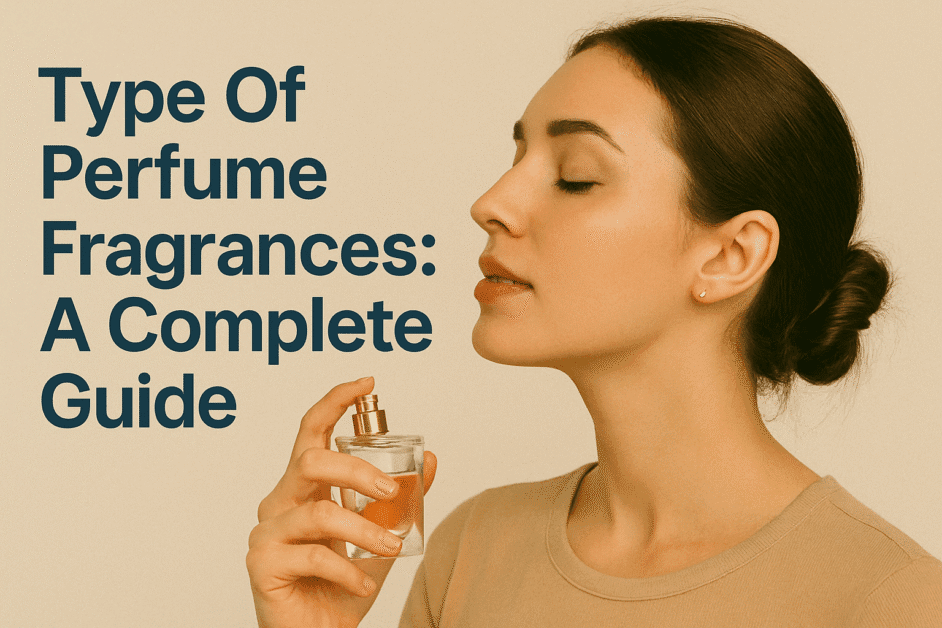Perfumes are more than just pleasant scents; they are an expression of our personality and style. Understanding the different types and categories of perfume fragrances can help us find the perfect scent that suits our preferences and makes us feel confident. In this complete guide, we will explore the various types of perfume fragrances, navigate fragrance notes, and discover the categories of perfumes based on concentration. Whether you’re a perfume enthusiast or a beginner, this guide will provide valuable insights to help you choose the right fragrance for any occasion.
Understanding Perfume Fragrance Types
Before understanding types of perfumes, it’s important to understand perfume fragrance types can help you select scents that align with your preferences and personality. Perfumes are typically categorised into several fragrance families based on their predominant scent notes and characteristics. Here are some common fragrance types:
1. Floral Fragrances
Floral fragrances are the most popular and one of the most loved perfume fragrance types. They capture the essence of various flowers, such as roses, lilies, and jasmine. Floral fragrances are feminine, and romantic, and evoke a sense of elegance.
2. Fruity Fragrances
Fruity Fragrances Perfume tantalises senses with a symphony of fruity notes, embodying freshness and vitality. Bursting with the essence of ripe berries, succulent citrus, and tropical delights, it evokes memories of sun-kissed orchards. A harmonious blend that captivates, leaving a trail of sweetness in its wake, inviting joy and delight.
3. Oriental Fragrances
Oriental fragrances captivate with opulent blends of spices, woods, and resins, evoking an aura of mystique and sensuality. Rich notes like vanilla, oud, and amber intertwine with exotic florals, creating an enchanting olfactory journey. These perfumes exude warmth and allure, leaving an unforgettable impression of luxury and intrigue.
4. Woody Fragrances
Woody fragrances evoke the essence of forests, blending warm, earthy tones with hints of cedar, sandalwood, and vetiver. These perfumes exude sophistication, masculinity, and depth, reminiscent of nature’s tranquility. With notes of amber and musk, they captivate with a timeless allure, leaving a lasting impression wherever they go.
5. Aquatic Fragrances
Aquatic Fragrances Perfume encapsulates the essence of oceanic serenity in every spray. Crisp, refreshing notes of sea salt, marine breeze, and driftwood evoke a sense of tranquility. Like a dip into azure waters, it lingers with hints of seaweed and citrus, embodying the timeless allure of the sea.
6. Gourmand Fragrances
Gourmand Fragrances captivate with decadent blends reminiscent of culinary delights. Their perfumes tantalise the senses, intertwining notes of vanilla, caramel, chocolate, and spices, evoking indulgent sensations. Each scent is a delectable journey, awakening cravings and memories, making Gourmand Fragrances a culinary adventure for the soul.
7. Citrus Fragrances
Citrus fragrances, vibrant and refreshing, embody the zest of sun-kissed fruits. Their invigorating blend of lemon, orange, and grapefruit notes creates an uplifting aroma that awakens the senses. Evoking memories of summer days and Mediterranean gardens, citrus perfumes offer a burst of energy and a touch of brightness to any occasion.
8. Fougere Fragrances
Fougère fragrances are a timeless olfactory delight, characterised by a harmonious blend of lavender, oakmoss, and coumarin. This aromatic composition exudes sophistication and freshness, captivating wearers with its earthy, herbal allure. Fougère perfumes evoke a sense of refinement and masculinity, making them enduring classics in the world of fragrance.
9. Leather Fragrances
Leather fragrances evoke sophistication with a blend of rugged charm. Bold and timeless, they intertwine smoky notes of tanned hides with hints of spice and woods, creating an alluring olfactory journey. These perfumes embody confidence and elegance, capturing the essence of luxury and adventure in every spritz.
Categories Of Perfumes
Perfumes are a fascinating blend of artistry and science, offering a wide array of scents to suit every preference. Perfumes are categorised based on their concentration of aromatic compounds, which determines their strength and longevity. Here are the main categories: Let’s dive into the enchanting world of perfumes and explore some of the prominent categories:
1. Parfum (or Extrait de Parfum)
They are the highest concentration of aromatic compounds, typically ranging from 15% to 40%. They offer the longest-lasting scent, often lasting for more than 8 hours. And due to its high concentration, it tends to be the most expensive type of perfume.
2. Eau de Parfum (EDP)
EDP typically contains a concentration of aromatic compounds ranging from 15% to 20%. They offer a long-lasting fragrance, typically lasting 4 to 8 hours, and provide a balance between potency and affordability.
3. Eau de Toilette (EDT)
EDT Contains a lower concentration of aromatic compounds, usually ranging from 5% to 15%. They offer a lighter fragrance than EDP, lasting around 2 to 4 hours. The main difference between eau de perfume vs eau de toilette is that EDT is more affordable than EDP, making it a popular choice for daily wear.
4. Eau de Cologne (EDC)
They contain the lowest concentration of aromatic compounds, typically ranging from 2% to 4%. They also offer a fresh and invigorating scent, lasting around 2 hours. EDC is generally used as a body splash or for a quick refreshing boost.
5. Eau Fraîche
They are similar to Eau de Cologne but with an even lower concentration of aromatic compounds. They offer the lightest scent and the shortest longevity, usually lasting less than 2 hours. These types of perfumes are suitable for a quick, subtle fragrance boost.
Navigating Fragrance Notes
Understanding fragrance notes is crucial when selecting a perfume. Fragrance notes are the different scents that emerge as the perfume dries down on the skin. Here are the three main categories of fragrance notes:
1- Top Notes
The top notes are the initial scents you smell when applying a perfume. They are light and volatile, meaning they evaporate quickly. Common top notes include citrus fruits, herbs, and aromatic spices. While top notes provide the first impression, they typically fade within the first few minutes.
2- Middle Notes
Middle notes, also known as heart notes, emerge once the top notes have evaporated. They are the main body of the fragrance and establish the perfume’s character. Middle notes can include floral, fruity, or spicy scents. They last longer than top notes but eventually give way to the base notes.
3- Base Notes
Base notes are the foundation of a perfume and emerge once the middle notes have faded. They are deep, rich, and long-lasting scents that linger on the skin for hours. Base notes often include woody, musky, or oriental ingredients. They provide the perfume with its lasting power and contribute to its overall complexity.
Conclusion
Choosing the right type of perfume fragrance can be a personal and enjoyable experience. By understanding the different types and categories of perfume fragrances, as well as navigating fragrance notes, you can find a scent that truly reflects your style and personality. Whether you prefer floral, oriental, woody, fresh, fruity, or gourmand fragrances, there is a perfume out there waiting to captivate your senses. Explore the world of perfumes, experiment with different scents, and let your fragrance express your unique self.
FAQs On Types Of Perfume
The main types of perfume fragrance families are floral, oriental, woody, fresh, fruity, and gourmand.
To determine which fragrance family suits you, experiment with different scents and see which ones resonate with your personal preferences and evoke the desired emotions.
The categories of perfume based on concentration, from highest to lowest, are parfum, eau de parfum, eau de toilette, and eau de cologne.
The notes in perfumes are significant as they contribute to the overall scent and character of the fragrance. They can be categorised into top notes, middle notes, and base notes.
Different types of perfumes typically last for varying durations on the skin. Parfums can last up to 24 hours, eau de parfums up to 8-10 hours, eau de toilettes up to 6-8 hours, and eau de colognes up to 4-6 hours.
Yes, you can layer different perfumes to create a unique fragrance blend. Experiment with different combinations and find the perfect blend that suits your taste.



